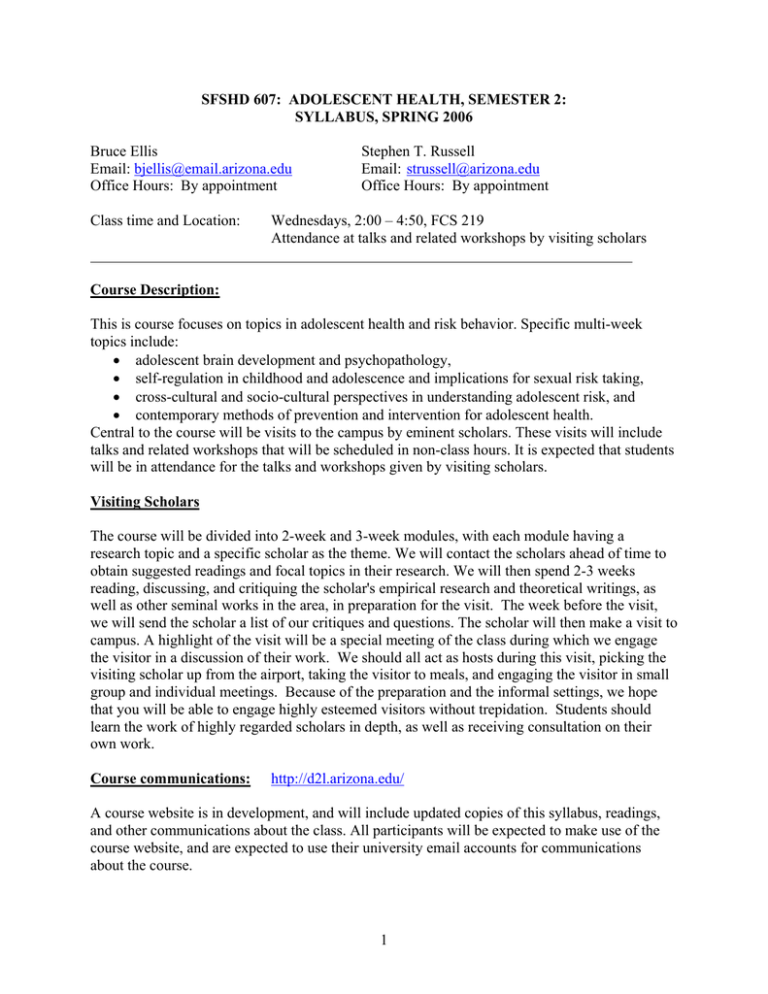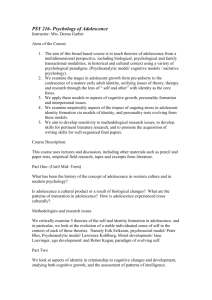
SFSHD 607: ADOLESCENT HEALTH, SEMESTER 2:
SYLLABUS, SPRING 2006
Bruce Ellis
Email: bjellis@email.arizona.edu
Office Hours: By appointment
Class time and Location:
Stephen T. Russell
Email: strussell@arizona.edu
Office Hours: By appointment
Wednesdays, 2:00 – 4:50, FCS 219
Attendance at talks and related workshops by visiting scholars
Course Description:
This is course focuses on topics in adolescent health and risk behavior. Specific multi-week
topics include:
• adolescent brain development and psychopathology,
• self-regulation in childhood and adolescence and implications for sexual risk taking,
• cross-cultural and socio-cultural perspectives in understanding adolescent risk, and
• contemporary methods of prevention and intervention for adolescent health.
Central to the course will be visits to the campus by eminent scholars. These visits will include
talks and related workshops that will be scheduled in non-class hours. It is expected that students
will be in attendance for the talks and workshops given by visiting scholars.
Visiting Scholars
The course will be divided into 2-week and 3-week modules, with each module having a
research topic and a specific scholar as the theme. We will contact the scholars ahead of time to
obtain suggested readings and focal topics in their research. We will then spend 2-3 weeks
reading, discussing, and critiquing the scholar's empirical research and theoretical writings, as
well as other seminal works in the area, in preparation for the visit. The week before the visit,
we will send the scholar a list of our critiques and questions. The scholar will then make a visit to
campus. A highlight of the visit will be a special meeting of the class during which we engage
the visitor in a discussion of their work. We should all act as hosts during this visit, picking the
visiting scholar up from the airport, taking the visitor to meals, and engaging the visitor in small
group and individual meetings. Because of the preparation and the informal settings, we hope
that you will be able to engage highly esteemed visitors without trepidation. Students should
learn the work of highly regarded scholars in depth, as well as receiving consultation on their
own work.
Course communications:
http://d2l.arizona.edu/
A course website is in development, and will include updated copies of this syllabus, readings,
and other communications about the class. All participants will be expected to make use of the
course website, and are expected to use their university email accounts for communications
about the course.
1
Readings:
Required readings are unmarked; additional readings are indicated by an asterisk (*).
Discussion leadership:
Each participant will lead one day of discussion; the discussion leader will be responsible for
guiding conversation on the readings. We will use a format we call “QCR” (questions,
comments, reactions). At minimum, everyone will be expected to post QCRs regarding the
required readings to the class website by 5pm on the Monday before our Wednesday class
meeting. (The class website discussion board could also be used to begin discussion before our
Monday class, but each individual is expected to email QCRs individually). The discussion
leader will review the questions, and the discussion leader will incorporate them into an outline
for class discussion.
Assignments:
Students are expected to meet with the instructors to develop a class project that will be
consistent with the focus of the class and complimentary to their research and coursework goals
and progress toward completion of the Ph.D.
Schedule:
A proposed semester schedule is listed below.
January 11
Introductions, course overview, expectations
January 18
Dahl: Adolescent brain development and psychopathology
Steinberg, L., Dahl, R., Keating, D., Kupfer, D., Masten, A., & Pine, D. (in press).
Psychopathology in adolescence: Integrating affective neuroscience with the study of
context. In D. Cicchetti and D. Cohen (Eds.). Developmental psychopathology, Vol. 1:
Theory and method. New York: Wiley.
Forbes, E.A., & Dahl, R.E. (2005). Neural systems of positive affect: Relevance to
understanding child and adolescent depression? Development and Psychopathology 17,
827–850.
Dahl, R.E. (2004). Adolescent brain development: A period of vulnerabilities and opportunities.
Annals of the New York Academy of Sciences, 1021, 1-22.
January 21; Saturday
(Suggested)
AIDS 2006: Forecasts and Future Leaders in the Fight
Location: Integrated Learning Center, UA Campus
January 25
Dahl: Adolescent brain development and psychopathology
2
Ernst, M., Pine, D. S., & Harden, M. (2005). Triadic model of the neurobiology of motivated
behavior in adolescence. Psychological Medicine, 35, 1-14.
Nelson, E. E., Leibenluft, E., McClure, E. B., & Pine, D. (2005). The social re-orientation of
adolescence: A neuroscience perspective on the process and its relation to
psychopathology. Psychological Medicine, 35(2), 163-174.
Dahl, R. E. & Hariri, A. R. (2005). Lessons from G. Stanley Hall: Connecting new research in
biological sciences to the study of adolescent development. Journal of Research on
Adolescence, 15(4), 367-382.
February 1
Dahl: Adolescent brain development and psychopathology
Guest visit to class from Richard Bootzin
May, J. C., Delgado, M. R., Dahl, R. E., Stenger, V. A., Ryan, N. D., Fiez, J. A., Carter, C. S.
(2004). Event-related functional magnetic resonance imaging of reward-related brain
circuitry in children and adolescents. Biological Psychiatry, 55, 359-366.
Dahl, R. E., Ryan, N. D., Matty, M. K, Birmaher, B., Al-Shabbout, M., Williamson, D. E.,
Kupfer, D. J. (1996). Sleep onset abnormalities in depressed adolescents. Biological
Psychiatry, 39, 400-410.
Dahl, R. E. (1996). The regulation of sleep arousal: Development and psychopathology.
Development and Psychopathology, 8, 3-27.
February 8
DAHL visit, colloquium
Adolescent Brain Development: A Developmental Period of
Vulnerability and Opportunity
McNamara, P., Dowdall, J., & Auerbach, S. (2002). REM sleep, early experience, and the
development of reproductive strategies. Human Nature, 13(4), 405-435.
*Wong, M. M., Brower, K. J., Ritzgerald, H. E., & Zucker, R. A. (2004). Sleep problems in
early childhood and early onset of alcohol and other drug use in adolescence. Alcoholism:
Clinical and Experimental Research, 28(4), 578-587. (Suggested Reading)
February 15
Crockett – Early adolescent sexual risk behavior
Bingham, C.R., & Crockett, L.J. (1996). Longitudinal adjustment patterns of boys and girls
experiencing early, middle and late sexual intercourse. Developmental Psychology, 32,
647-658.
3
Crockett, L.J., Bingham, C.R., Chopak, J.S., & Vicary, J.R. (1996). Timing of first sexual
intercourse: the role of social control, social learning, and problem behavior. Journal of
Youth & Adolescence, 25, 89-111.
February 17
Crocket Colloqium
February 22
Crockett – Self-regulation
Crockett, L.J., Raffaelli, M., & Shen, Y-L. (in press). Linking self-regulation and risk proneness
to early sexual behavior: Pathways through peer pressure and early substance use.
Journal of Research on Adolescence.
Colman, R.A., Hardy, S.A., Albert, M., Raffaelli, M., Crockett, L. (in press). Early Predictors of
Self-Regulation in Middle Childhood. Infant and Child.
Raffaelli, M., & Crockett, L.J. (2003). Sexual risk taking in adolescence: The role of selfregulation and attraction to risk. Developmental Psychology, 39(6), 1036-1046.
March 1
Schlegel: Cross-cultural perspectives on adolescence
Schlegel, A. & Barry, H. (1991). Adolescence: An Anthropological Inquiry. New York: The
Free Press. Chapters 1 and 2.
Weisfeld, G.E. & Janisse, H.C. Some functional aspects of human adolescence. In In B.J. Ellis & D.F.
Bjorklund (Eds.), Origins of the social mind: Evolutionary psychology and child development. New
York: Guilford Press.
March 8
Schlegel: Cross-cultural perspectives on adolescence
Schlegel, A. & Barry, H. (1991). Adolescence: An Anthropological Inquiry. New York: The
Free Press. Chapters 5 and 7.
*Schlegel, A. & Barry, H. (1991). Adolescence: An Anthropological Inquiry. New York: The
Free Press. Chapter 6.
Rough draft – class project
March 15
- NO CLASS: SPRING BREAK -
March 22
- NO CLASS: SRA CONFERENCE -
March 29
Socio-cultural perspectives on adolescent health
Diaz, R.M., Alaya, G., Bein, E., Henne, J., & Marin, B.V. (2001). The impact of homophobia,
poverty, and racism on the mental health of gay and bisexual Latino men: Findings from
3 US cities. American Journal of Public Health, 91(6), 927-932.
4
Zambrana, R.E., Cornelius, L.J., Boykin, S.S., & Lopez, D.S. (2004). Latinas and HIV/AIDS
Risk Factors: Implications for harm reduction strategies. American Journal of Public
Health, 94(7), 1152-1158.
*Diaz, R.M. Findings from Behavioral Research from Latino Gay Men and HIV. New York:
Routledge, 1998, pp.35-49.
*Heubner, D.M., Rebchook, G.M., & Kegeles, S.M. (2004). Experiences of harassment,
discrimination, and physical violence among young gay and bisexual men. American
Journal of Public Health, 94(7), 1200-1203.
*Ramos, R., el al. Men I mess with don’t have anything to do with AIDS: Using ethno-theory to
understand sexual risk perception. The Sociological Quarterly 36: 483-504 (95).
April 1 (Saturday)
Women's Health: Bridging the gap between sex-based biology
and psychosocial perspectives
UA Campus
April 5
Prevention / intervention
Prinz, R.J. (2002). The Fast Track project: A seminal intervention efficacy trial. Journal of
Abnormal Child Psychology, 30, 61–63.
The Conduct Problems Prevention Research Group (2002). The implementation of the Fast
Track program: An example of a large-scale prevention science efficacy trial. Journal of
Abnormal Child Psychology, 30, 1–17.
Stephen P. Hinshaw, S.P. (2002). Prevention/Intervention trials and developmental theory:
commentary on the Fast Track special section. Journal of Abnormal Child Psychology,
30, 53–59
Rotheram-Borus, M.J., O’Keefe, Z., Kracker, R., & Foo, H. (2000). Prevention of HIV Among
Adolescents. Prevention Science. 1(1), 15-30.
April 12
Prevention / intervention
Brown, G., Browne, J. A., & McGee, F. (2005). An Ontario initiative to enhance the
effectiveness of AIDS service organizations: Community-linked evaluation of AIDS
resources. Journal of the Association of Nurses in AIDS Care, 16(2), 49-52.
Oliva, G., Rienks, J., & Netherland, L. (2004). Critical collaborations in serving high-risk
women: The PHREDA Project. Pp. 133-162 in Preventing AIDS: Community-science
collaborations.
5
Luna, G.C., Rotheram-Borus, M.J. (1999). Youth living with HIV as Peer Leaders. American
Journal of Community Psychology, 27(1), 1-23.
April 19
Doug Granger: Hormones and Behavior
Hood, K. E., Dreschel, N.A., & Granger, D.A. (2003). Maternal behavior changes after immune
challenge... Developmental Psychobiology, 42, 17-34.
Kivlighan, K.T., Granger, D.A., & Booth, A. (2004). Gender differences in testosterone and
cortisol in response to competition. Psychoneuroendocrinology, 30, 58-71.
Cameron, J.L. (2004). Interrelationships between hormones, behavior, and affect during
adoelscence. Annals of the New York Academy of Sciences, 1021, 110-123.
Granger, D.A. et al. (2003). Salivary testosterone diurnal variation and psychopathology in
adolescent males and females. Development and Psychopathology, 15, 431-449.
April 26
Pubertal Development
Shirtcliff, E.A. (2005). Neuroendocrine and Neural Contributions to Pubertal Development,
Normative Adolescent Development, and Affect-Related Behavior Problems. Workshop on the
Synthesis of Research on Adolescent Health and Development.
April 28
Douglas Granger Visit, Colloquium
Integrating Salivary Biomarkers into the Study of Health and
Human Development: Problems, Prospects, and Future Directions
May 3
Class Paper Due: Last day of class
6






